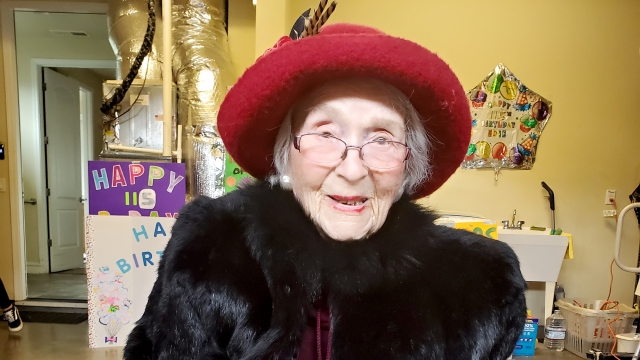Edie Ceccarelli of Willits, California, celebrated her 116th birthday Monday. She was born Feb. 5, 1908.
Ceccarelli is the second-oldest living person on the planet and the oldest American, according to the Gerontology Research Group, which tracks supercentenarians — people 110 years of age or older.
Ceccarelli celebrated by watching her neighbors in the small Mendocino County town drive by in a parade.
She now lives with dementia. But on past birthdays, she told local paper The Press Democrat that her longevity was from "drinking two fingers of wine a day and minding her own business."
María Branyas Morera is the oldest living person, according to Guinness World Records. She lives in Spain, and was born in San Francisco on March 4, 1907.
What does it take to make it to supercentenarian or centenarian status? Researchers with Boston University's New England Centenarian Study, the largest study of centenarians (100-year-olds) and their families in the world, have found our genes play about 70% of the role in making it to 110, but to get to age 90 our genes play only about 30% of that role.
"You should be able to live about 95 years. That's the capacity of the human machine. Edie, you know, she's an outlier — she won the genetic lottery," Dan Buettner told Scripps News. Buettner has spent the past 20 years researching blue zones, a handful of communities across the globe with the largest number of people living to 100.
The blue zones are Sardinia, Italy; Ikaria, Greece; Nicoya, Costa Rica; Okinawa, Japan, and Loma Linda, California.
Buettner, an American National Geographic Fellow and New York Times bestselling author, has made a cookbook and frozen meal line inspired by blue zone diets, and created a docuseries on Netflix that was released last year.
"These people don't try to live a long time. They don't have better genes. They don't have better discipline. They don't have better programs. They simply live in environments where the healthy choice is the easy choice," Buettner said.
Those choices include a mostly plant-based diet and daily movement.
"Science tells us that if we live in a walkable city, we'll get about 20% more physical activity than we will if we live in an unwalkable city and rely on going to the gym, which is something that most people don't do for the long run," Buettner said.
That is where California may have a leg up, Buettner says. Like the other blue zones, the state is located where the climate encourages growing a garden, or being outside to increase activity or vitamin D exposure.
"[It] allows you to, makes it easy to be active all year round. That does have an impact," Buettner said.
Finding a purpose through hobbies and volunteering or work is another common blue zone habit. Community is also key, like being close to family or having a few close friends, especially as officials continue to declare loneliness a health epidemic. Doctors have said it can harm the body and mind.
"People have a higher risk of cardiovascular disease, Type 2 diabetes, immune diseases or respiratory illnesses, even dementia and Alzheimer's disease. It can really cause that wear and tear on our body," geriatrician and researcher Dr. Ashwin Kotwal said.
But just like 116-year-old Edie, there is good news to celebrate still: New census data out this month projects the number of centenarians, which continues to trend upward, will quadruple over the next three decades.
SEE MORE: Why does U.S. life expectancy rank poorly?
Trending stories at Scrippsnews.com


